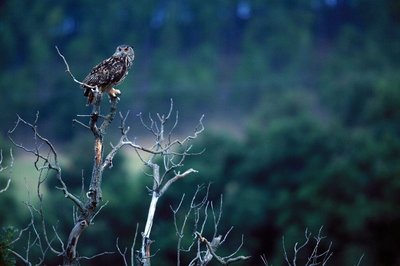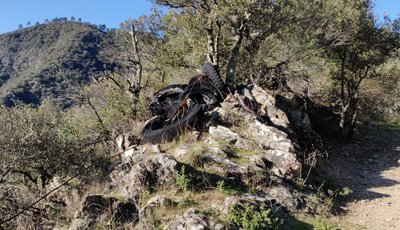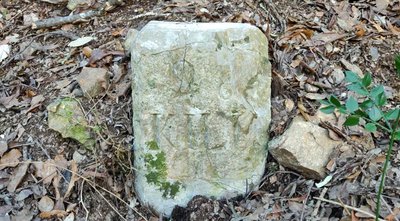
The stagecoach
7 points of interest

Tancat sur le ruisseau de Vallongue - Béatrice Galzin  Water
WaterHydraulic heritage
In the valley of Valescure, an integration project for the unemployed and socially disadvantaged restored over 450 hydraulic engineering structures, supervised by various institutional and scientific partners. This project helps you understand the importance of hydraulic dams in the Cévennes: tancats (small thresholds or dams built across the waterway to recover any sediment carried by rainwater runoff), païssières (thresholds, little dams), béals (irrigation channels), trancats (rainwater drains carved into the rock or constructed uphill of buildings to channel rainwater and protect the buildings).
Château de Valescure - Béatrice Galzin  History
HistoryChâteau de Valescure
The Château de Valescure, a private property owned by the French Forestry Office (ONF) since 1922, must have been built in the 15th century by Bertrand de Valescure, whose descendants were ennobled and distinguished themselves during the French Wars of Religion. They held the seigneury of Valescure until 1618, when by alliance it became the Tourtoulon family’s, which held it until the French Revolution. Long empty, in 1941 the château came back to life when it became an advance post of the Chantiers de jeunesse (a paramilitary youth institution of the Vichy regime). Later in the Second World War, Resistance fighters found refuge here. In 1985, the ONF began renting it out.

La chouette chevêche - Descamps R  Flora
FloraA preserved valley
The Vallée Obscure, a natural zone of ecological, faunal and floral interest, has a significant heritage of rare species, such as the nightjar, little owl, bee-eater, raven and honey buzzard... As for flora, almost ten varieties of orchids have been identified. In spring, snapdragon is common on the rocky slopes. In the valley, there are also Atlas cedars and tall thujas, planted by the ONF in the 1950s.

 Water
WaterPrecious reserves
To store water, especially during dry periods, locals have dug and built a great number of gorgas. These reservoirs supplied gardens, fields and mills. They were fed by springs or streams, whose water was diverted by a paissièira and then transported by a besal (béal).

 Water
WaterVital arteries
Besals or béals are channels that have been built to carry and distribute water where it is needed: plots of cultivated land, gardens, mills, etc. They were usually created and maintained collectively. The distribution of water to the various users was controlled by small sluice gates (esclafidors). These were opened and closed at precise times of day, which were decided according to customary law – and could be subject to disputes and legal proceedings.

Cable de transport de materiaux - Béatrice Galzin  History
HistoryCobbled paths and retaining walls
Under your feet, you will see traces of all this old built road heritage on the paths. Cobblestones make roads more comfortable and suitable for vehicles.
The retaining walls are regular and, in places, built on very steep areas or carved into the rock. The traces left by humanity are impressive.
After the Château de Bussas, you will see piled-up tyres by the side of the path. There is also a thick cable. The taut-cable system made it possible to transport materials and wood all the way to the road. When the load arrived, it had sometimes picked up too much speed because of its weight. The pile of tyres was there to stop it.
Borne kilométrique sur l'ancienne route départementale 20 - Béatrice Galzin  Architecture
ArchitectureSoucy bridge and the D20 road
The magnificent stone bridge that straddles the Gardon river was built in July 1872.
On 14 June 1872, François Poujol requested permission to build a submersible bridge over the Gardon de St- André, between the D 20 and the new RN 107, in Les Soucis in the municipality of St-Martin de Corconac.
The road that we take today between Soucy bridge and L’Arénas was the only road on the valley floor. It was disused in 1873 when the new RN 107 (now the RN 907) was built on the slope opposite. Try to find the distance marker, which is on the edge of the path.
Description
Signposts will guide you all along this route, as well as yellow painted waymarks. In the description below, the signposted place names and/or directions are given in bold italics between quotation marks:
Starting from the car park, turn right onto the D road and, 200m later, go downhill on the left on the small road towards "Col du Briontet" via "Pont de L'Arénas", "Vallée Obscure" and "Château de vallée obscure".
- At “Château de vallée obscure” take the path on the right and, in the first hairpin bend, take the path that climbs straight ahead to "col du Briontet".
- At “col du Briontet”, go towards "Col du Mercou" on a wooded path on your right, which goes uphill between two forestry tracks.
- At “col du Mercou”, take the path on your right towards "Soucy". The path first follows a track/road for 200m, then forks left onto a path to join a road that goes downhill to "Pont Neuf" and "Pont de Vallongue".
- Before the first house in Pont de Vallongue, take the path on your right which makes for the brook; cross the brook.
- After two fords, you arrive in "Soucy". NB. Stay on the path!
- At the waterway, turn right, go past the front of the "Château de Bussas", and continue to "L'Arénas" and then "Pont de l'Arénas".
- At "Pont de l'Arénas", turn left to "La Planque" to return to the D road and your car park.
- Departure : La Planque bend in the road – Peyrolles
- Arrival : La Planque bend in the road – Peyrolles
- Towns crossed : Peyrolles, Soudorgues, and L'Estréchure
Forecast
Altimetric profile
Recommandations
Before committing yourself to a circuit, ensure that it is suitable for your activity level and ability. Remember that the weather changes quickly in the mountains. Take enough water.
Information desks
Tourism & national parc'house
Col de la Serreyrède, 30570 Val d'Aigoual
The Maison de l'Aigoual houses the tourism office Mont Aigoual Causses Cévennes and the Maison du Parc national. This visitor centre provides information on and raises awareness of the Cévennes National Park, its sites and events as well as the rules that must be observed in the National Park's central zone.
On site: changing exhibitions, video projections, Festival Nature events and shop Open year-round
Tourism office Mont Aigoual Causses Cévennes, Saint-André-de-Valborgne
les quais, 30940 Saint-André-de-Valborgne
This office is part of the National Park's associated tourist-information network, whose mission is to provide information on, and raise awareness of, the sites and events as well as the rules that must be observed in the National Park's central zone.
Transport
(not during school holidays)
Access and parking
Parking :
Calculateur d'itinéraire Lio
Utilisez le calculateur liO pour organiser votre trajet en région Occitanie.
Autres régions
Calculez votre itinéraire en Auvergne Rhône Alpes sur Oùra
Biodiversité autour de l'itinéraire
Source

Report a problem or an error
If you have found an error on this page or if you have noticed any problems during your hike, please report them to us here:


